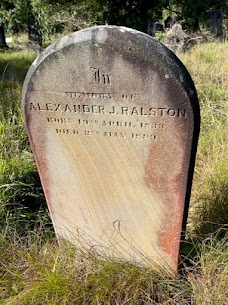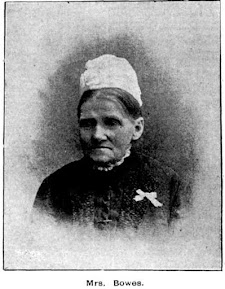A home full of history
Today's blog had its roots in an old home
obscured by large trees in the inner Sydney suburb of Ashfield.
It was, and still is, a large house with a long
cast iron columns along the ground floor verandah while the first-floor
verandah has timber posts with fretwork balustrades. It stands on a large
allotment in Bland Street, surrounded by mature camphor laurel, Lilly Pilly and
cabbage palm trees to name just a few.
I used to pass the property daily walking to the
train station, heading to work in the CBD but this was decades ago. I recently
revisited the area and decided to put my curiosity to rest and dig into the
history of "Lynngrove" formerly "Falconshaw" and some of
it's occupants. What a treasure trove I found!
ALEXANDER JAMES RALSTON
Alexander was born in Launceston Tasmania in
April 1833 into the large family of Gavan and Emily Ann Ralston. He left the island
and headed to Melbourne whilst a young man and was a member of a large business
firm. Alexander became dissatisfied with his employment and moved to Sydney
where he married Edith Windeyer Thompson in 1860 (more on her family later).
Two years later he gained the position of Clerk
of Public Records of the Legislative Assembly and in 1864 he left the Civil
Service for a position in the Australian Mutual Provident (AMP) Society as
Assistant Secretary. At the time the Society was in disarray and the then
Secretary, Cashier and Accountant all resigned. Alexander was made Secretary, a
position he held successfully until 1886 when he retired. During that time, he
became father to six children.
Alexander purchased 4 acres of the original
Ashfield Park Estate in 1876 on the eastern side of Bland Steet opposite St
John's Church where he built an eleven roomed two storey brick house, naming it
"Falconshaw".
Alexander died in May 1889 in the residence
leaving a widow and four of his children to mourn his loss; one had died in infancy,
and another had predeceased him.
Alexander James Ralston lies alone in an outer
part of the old Anglican area very close to Railway Street. His headstone does
not appear to be from the time of his passing but may have been replaced. I am unable
to advise any further.
His wife, Edith, was the granddaughter of
Charles Windeyer. Charles, a Magistrate, arrived in Sydney with his wife and
nine children (he left his eldest son in England) in July 1828 and soon found
employment as the chief clerk of Police, promoted to assistant superintendent
of Police in 1830. In 1842, when Sydney was incorporated as a city, he became
the first Mayor.
Her cousin, Sir William Charles Windeyer, was a
Supreme Court judge. One of his rather notorious cases was presiding over the
Mount Rennie rape case of 1886. His daughter and Edith's niece was Margaret
Windeyer, a feminist and member of the Womanhood Suffrage League of NSW which
her mother founded. Margaret went to New York and became familiar with the
Dewey Decimal Classification and returning to Sydney joined the NSW Library as
a cataloger, one of the first woman employed there.
ALEXANDER GERARD RALSTON
Alexander was the first son of Alexander James and
Edith Ralston and born in 1860. He was educated at Sydney Grammar School and
the University of Sydney where he gained his MA in 1883. In 1882 he married
Mary Emily Windeyer a distant relative at Raymond Terrace NSW. Alexander studied
to be a lawyer and was admitted to the Bar in 1884, making King’s Counsel in
1906. He was Acting District Court Judge many times from 1894 and Acting Judge
of the Supreme Court in 1919 He was on the Royal Commission to consolidate
Statute Law.
Alexander
Gerard had a long association with local government and was Alderman of Ashfield
Council and subsequently Burwood Council where he was later the Mayor. A Patron
of the Sydney School of Arts he also served on the board of the Zoological
Society. Alexander Gerard lived in “Kooroogama” in Wentworth Road, Burwood for
many years. He retired in 1926 after ill health, dying in Woollahra in 1932 and
survived by his widow and three of his four sons: his two daughters predeceasing
him.
Two of his sons enlisted in WW1, his eldest, Alexander Windeyer Ralston, a Barrister, was an early recruit in August 1914. After serving in Rabaul, PNG, he returned home but soon re-enlisted with the AIF. In May 1915 he was appointed Major with the 19th Battalion and went on to serve in Gallipoli up to the evacuation in December 1915. In June 1916 he was appointed Lieutenant Colonel with the 20th Battalion and was thought to have been one of the youngest Colonels serving with the Allied Forces.
Alexander Windeyer
was highly decorated earning the Distinguished Service Order for actions near
Pozieres in 1916. He also was awarded the Companion of the Order of St Michael
and St George for his work in France in April 1917.
His younger
brother, Edward Bolton Ralston also served during World War I, as a Lieutenant
with the 1st and 12th Light Horse Regiments. He was badly wounded in the arm
during the charge of the Light Horse Brigade at Beersheba on 31 October 1917
and was invalided home to Australia in 1918.
The vast
majority of the family and those mentioned here are buried in St Thomas’
Enfield.
But what of
the home now known as “Falconshaw”?
After
Alexander James Ralston’s death in 1889, his widow sub-divided the property in
1890. The house block was sold to Marie Ellis, wife of James Ellis and the name
changed to “Altona” When the mortgagee, AMP, sold the property in 1904 to the
Brierley’s more subdivision took place and the name was changed to “Lynngrove”
Lynngrove (formerly Falconshaw)
In my
research I found that an Edward Ecroyd who died on the property in 1931 was the youngest son of William
Farrer Ecroyd, a former British MP, and also the great-grandson of his
namesake who founded cotton spinning mills in Nelson, Lancashire. Edward was
also related to William Farrer, the man who founded the “Federation” strain of
wheat and became known as the “father of the Australian wheat industry”.
Edward Ecroyd
lies in the old Anglican area of Rookwood Cemetery with his third wife, Minnie.
Well, what a
tangled web we weave! A little overwhelming, I have to say, and all this came
about from the admiration of a tree-sheltered home in Bland Street Ashfield, Sydney.
The story
about the home of “Falconshaw” and that of Alexander James Ralston is vast and
I have told it as succinctly as I could.
The
research I used is all freely available via Ancestry.com, Google and Trove search
engines.
If you wish
to make any comments please do so here if you have access to blogspot, or at
the group facebook page under
rookwoodcemeterydiscoveries
Or send me
a personal message at my email
lorainepunch@gmail.com








Another very interesting story, I love learning about our old stately homes and their history…💐
ReplyDeleteYes, I love an old building and love finding its history and the history of those that built it or lived there
Delete